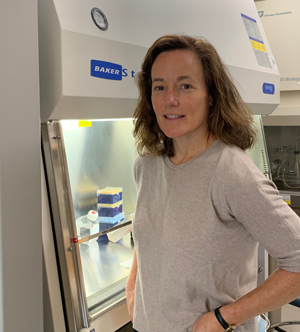Research from the lab of Sharon Cantor, PhD, professor of molecular, cell & cancer biology, upends the conventional model of how chemotherapy works. In particular, she provides a new understanding of a PARP inhibitor (PARPi), a chemotherapy drug commonly used against breast and ovarian cancer.

It is conventionally thought that hereditary breast and ovarian cancers are vulnerable to drugs that cut the tumor DNA in half. Indeed, cancer cells mutated for the hereditary breast and ovarian cancer genes, BRCA1 and BRCA2, are both defective in repairing broken DNA and are sensitive to the PARPi drug. The effectiveness of PARPi against cancer cells with mutations in the BRCA genes led researchers to try the PARPi treatment on other cancers with defects in DNA repair, hoping for similar positive results.
While promising results have bolstered a billion-dollar pharmaceutical industry, the chemotherapy does not always work or resistance develops, causing patients to suffer. What’s more, sometimes the PARPi unexpectantly works when tumors do not have a DNA repair defect, suggesting something in the understanding of the drug mechanism of action is wrong.
“The old theory made sense,” Dr. Cantor explained. “It checked all the boxes. It looked like the double strand breaks should be the culprit. But the model didn’t fit the results we were seeing. We had to rethink the model.”
Using new assays and technologies now available, her group observed that the PARPi did not split tumor DNA in half; rather it created holes in the DNA. Furthermore, her group observed that PARPi was the most effective on tumors that already had holes in their DNA, which made them particularly fragile.
“If the tumor DNA resembles Swiss cheese to begin with, the addition of more holes by the PARPi causes the tumor to die,” she said.
What is even more telling is that the cancers that learned to fill those holes and make their DNA solid again were able to survive the PARPi. “It was really dramatic. You could see the results right away. Every time we would get sensitivity to the drug, we’d get these DNA holes. And every time we got drug resistance or tumor recurrence, we got no holes,” said Cantor.
These findings, published in Molecular Cell, will impact future biomarkers, drug development and treatment for cancer drug resistance. “If we want a more accurate idea of what tumors would be treatable with PARPi, we need a test that scans for these DNA holes and not the double stranded breaks or the proteins that repair them that currently underlie the standard ‘HRD’ test.”
More accurate testing would reduce the risk of developing drug resistance or tumor recurrence in the clinic. It would also reduce patient exposure to toxic chemotherapies, treatments that are not likely to be beneficial in the long run.
Cantor also foresees these findings helping researchers design better drugs and better drug combinations to more effectively treat these tumors.
“We want to know how the tumors are outwitting the treatment,” said Cantor. “It’s only by understanding the model of action—why the drugs work—that we can develop more effective treatments and prevent drug resistance.”
Related stories on UMassMed News:
For GSBS class speaker Sumeet Nayak science brings hope
UMMS researchers forging new understanding of BRCA cancer gene function with NCI grant